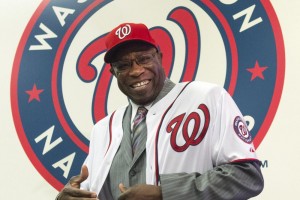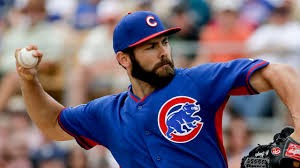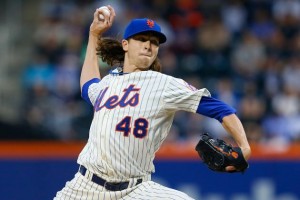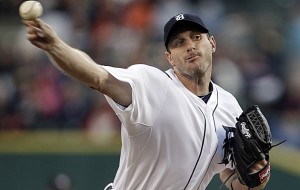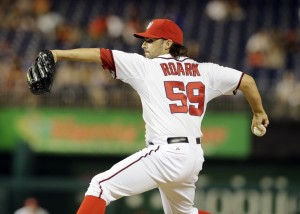Since our season is over (but the hot-stove has not yet kicked in), i’ll piggy back on the recent posts to this same topic done by Mark Zuckerman at MASN and by Chelsea Janes at WP.
Their posts both touched on some of the same issues; i’ll take those issues and add in a few of my own.
Major issues for the Nats to address this coming off-season, how I would address them and what I think the team will do:
- Resolve Dusty Baker situation. Many reports have noted that the team wants him back and that he wants to return. I see little that he could have done differently in the 5-game NLDS loss to use as evidence that he’s not the right guy (you can’t lose when your pitchers throw 6 no-hit innings in playoff starts), and he’s so clearly a better man-manager than his predecessor Matt Williams that I see no reason not to extend him. I know that the Lerner’s don’t like to do long term contracts, and lets just hope they offer Baker the raise he deserves for two straight division titles (and, in my opinion, the NL Manager of the Year in 2017 award that he should get for working around so many injuries this year).
- Should we bring back Jayson Werth? Yes he’s the “club house leader,” yes he’s been here for seven years and has settled in the DC area. But he struggled this year with both injuries and performance, is entering his age 39 year, posted a negative bWAR in 2017, and the team has a surplus of outfielders who are probably MLB “starters” heading into 2018, more than we can even field. I think the team says to Werth something along the lines of the following: Go see if you can find a DH/part time OF job in the AL for a couple years until you’re done playing and then we’ll hire you back as a special assistant/hitting instructor/bench coach or something. I’m not entirely convinced that Werth is a DC lifer though; he’s been kind of a nomad in his career. Drafted by Baltimore, traded to Toronto (with whom he debuted), traded to the Los Angeles Dodgers, signed as a FA with Philly for four years, then with us for seven. Yes he’s been with us the longest, but this isn’t a situation like Ryan Zimmerman where we’re the only org he’s known. I think he heads off to the AL for a couple years then comes back to the fold with a front office job.
- What do we do at Catcher? I’ll quickly repeat what we’ve been discussing in the comments of previous posts; yes I know Matt Wieters struggled badly at the plate this year, yes I know he botched the 5th inning of that fateful game 5. But he’s not going to decline a $10M offer after this season, nor is the team going to swallow that amount of money. Prepare yourselves for another season of Wieters, who we can only hope bounces back in his “contract year” and gets a bump in performance. Meanwhile, as much as we love the Jose Lobaton cheerleader routine, we do need more production from the backup. Even though Lobaton got just 158 ABs this year, he still managed to put up a -1.0 bWAR figure. That’s hard to do. If only we could just have him only play for us in the playoffs … (big hit in game 5 in 2017, the clutch 3-run homer in 2016). I suspect the team will go with Wieters and Pedro Severino as his backup, getting Severino at least two starts a week to get him up to speed on MLB pitching, then making a 2019 decision based on whether Severino looks like he could hit enough to be a full time starter or if he remains the backup to some FA acquisition. We have others in the pipeline who may prove themselves worthy soon (Raudy Read in AAA, Taylor Gushue in AA, Jakson Reetz in High-A, Tres Barrera in Low-A, plus long-serving minor leaguers Spencer Kieboom and Jhonatan Solano in the AAA fold who may or may not come back for 2018).
- Will they pursue FA extensions with key players? Namely, Bryce Harper, Anthony Rendon and Daniel Murphy. Lets take them one by one:
- Harper: lets face it, there’s NO WAY he’s not hitting free agency. Scott Boras client with a chance to set the all time contract record? Both guys have the ego required to pursue that avenue. And yes, while some Boras clients (Stephen Strasburg) have taken pre-FA deals, very few do. You hire Boras generally to get the biggest value deal and to leverage his relationships with owners so as to negotiate directly with them and that’s what Harper will do.
- Rendon: he’s still got two arb years: what I think the team will do is do a 2-year deal to buy out the Arb years and get cost containment. MLBtraderumors projected Rendon’s arb salary for 2018 at $11.5M and they’re usually pretty accurate; I could see the nats offering Rendon a 2yr/$26M deal for $10M in 2018 then $16M in 2019 or something like that … maybe a little higher in his final year given his MVP-calibre season. That’d be good for the team because Rendon might be a $20M/year player, and good for Rendon b/c he’s injury prone. Past this though … Rendon is also a Boras client but he projects to me kind of like Strasburg in that he’s low-key and may want to commit to DC longer term. Of course, Rendon is also a Houston lifer (born, high school and college there) so he could also want a return trip home to play for his home town team. Probably an issue for the 2020 hot-stove season.
- Murphy: the Nats have gotten such a huge bargain with the Murphy signing. He’ll only be 34 at the beginning of his next deal, and he plays a position (2B) that isn’t nearly as taxing as an OF or other infield position. I would feel completely comfortable offering him another 3 year deal, increasing the dollars to maybe $16M/year (3yrs/$48M).
- Do they need to pursue a Starting Pitcher? Absolutely, 100% yes. Joe Ross is out for basically the whole of 2018, they traded away all their AAA depth last off-season, and the guys remaining in AAA (A.J. Cole and Erick Fedde) did not grab the 5th starter job like they had the chance to in 2017. Edwin Jackson probably earned himself a shot elsewhere but was too inconsistent for my tastes. I think the team splurges here, trying to get the best additional veteran starter they can find either on the free market or in trade. The market for starters is intriguing: Yu Darvish, Jake Arrieta are Cy-Young quality arms available. There’s some decent SPs like Masahiro Tanaka and Johnny Cueto who can opt out but who also may just stay put. There’s #4 starter types like Lance Lynn and Jeremy Hellickson who are available and could be good 5th starters for us. There’s guys who have put up good seasons but have struggled lately (Jaime Garcia, Francisco Liriano, Clay Buchholz) who could be intriguing. So it’ll be interesting to see who they get.
- What is the Nats 2018 outfield? Do they stick with Internal options or do they hit the FA/trade Markets? I like a potential 2018 outfield of Taylor/Eaton/Harper. I like Taylor in CF providing better defense than Eaton right now, given that ACL injuries really are 2-year recoveries. Given Taylor’s big 2017 and his “Michael A Tater” NLDS, he’s more than earned a starting spot in 2018. That leaves some surplus in the OF for 2018 … something we’ll talk about next. There are some intriguing names out there on the FA market (J.D. Martinez, Justin Upton, Lorenzo Cain) who could slot into either LF or CF as needed and give a hopeful boost to the offense … but are any of those guys and their 8-figure salaries guarantees to be better than the cost-contained Taylor? I don’t think so, and that’s why I think we stick with him.
- Do the Nats leverage their sudden depth of position players in trade this off-season? In particular, i’m talking about Wilmer Difo and Brian Goodwin, both of whom played extremely well when given the opportunity and who both proved that they’re MLB starting quality. If we stick with Taylor as a starter, then you have both Goodwin and Andrew Stevenson as able backups and that’s one too many. If we (going back to the previous point) buy another outfielder, then that’s even more surplus. I’m of the opinion that the team needs to sell high on both Difo and Goodwin and acquire needed assets (5th starter, bullpen help, near-to-the-majors pitching prospects).
- What do we do with the bench? Drew, Lobaton, Kendrick, de Aza, Raburn all FAs, Lind has a player option but may want to try to parlay his excellent PH season into a FTE job. So that leaves … not much.
- We have already talked about a backup catcher above
- We need a RH bench bat who can play corners (1B/LF): that was Chris Heisey to start the year .. but he’s long gone. Kendrick ably filled this role … but he won’t sign back on as a utility guy given his excellent 2017.
- If Lind doesn’t exercise his $5M player option, we’ll need a big bopper lefty on the bench again. We do have a guy like this on the farm and on our 40-man (Jose Marmolejos) but is he MLB ready? He had a nice AA season, but AA to the majors is a jump.
- If we flip Difo, we’ll need a backup middle infielder. Do we keep him assuming that Turner/Murphy will get hit with injuries (as they both are apt to do?) Turner missed months, Murphy missed nearly 20 games in each of the past two years; is that enough to keep someone around versus flipping them?
- We do seem OK with backup outfielders right now, assuming that Andrew Stevenson is sufficient as a 4th OF/CF-capable defensive replacement/pinch runner type.
So, that’s potentially a brand new bench. Luckily its not too hard to find veteran big-hitting RH or LH bats; we seem to do this every year and have some luck. Middle infielders? Would you sign up for another year of Drew? I don’t think I would at this point; he just seems to brittle to count on. I suspect the team will be quite active in this area.
9. What do we do with the bullpen? Right now, given the departing FA relievers (Perez, Kintzler, Blanton, Albers), our “standing pat” bullpen for 2018 looks something like this:
- Closer: Doolittle
- 7th/8th inning guys: Madsen, Kelley, Glover
- Lefties: Solis, Romero
- Long Man: Grace/Cole
- Minors options: Adams, Gott
So, that’s a pretty solid looking bullpen if two guys in particular are healthy: Kelley and Glover. Our entire strategy in the off-season seems to hinge on the health of these two. I have no guesses; so lets assume one of them is good and one of them has a significant all of 2018 injury. That means we probably pursue another Matt Albers type in the off-season. Meanwhile, there’s a difference of opinion on the value of both our current lefties: Romero’s ancillary numbers were barely adequate and lefties hit him for nearly a .300 BAA, so he’s not exactly an effective lefty. Solis blew up this season, posting a seasonal ERA of nearly 6.00 (his FIP was much better) and getting demoted at one point. But he gets lefties out, Baker trusts him, and I can’t see him not being a part of the solution. If the team thought they could improve upon Romero, perhaps they also pursue a lefty reliever (or resign the swashbuckler Perez). I’m ok with Grace as a long man (though his K/9 rates leave something to be desired) but I’d also like to see the team convert Cole to relief at this point. There’s some options issues to consider; Solis, Romero, Cole, and Grace are all out of options for next year, so they all either make the team or get cut loose.
So Summary:
- Bring back Baker
- Say good bye to Werth
- Stand pat on catcher with internal options
- Buy out Rendon’s arb years this year, talk about Murphy next year
- Get a decent 5th starter
- Go with Taylor/Eaton/Harper with Stevenson as your backup in the OF
- Yes, trade Goodwin and Difo for stuff
- Get one middle RH reliever, one middle LF reliever, convert Cole to relief
- Cattle call for bench bats next spring.
Am I missing anything? Lots of talking points here.
